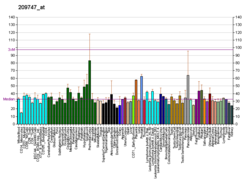| TGFB3 |
|---|
 |
|
| Structures disponibles |
|---|
| PDB | Recherche d'orthologue: PDBe RCSB |
|---|
| Identifiants PDB |
|---|
1KTZ, 1TGJ, 1TGK, 2PJY, 3EO1, 4UM9 |
|
|
| Identifiants |
|---|
| Aliases | TGFB3 |
|---|
| IDs externes | OMIM: 190230 MGI: 98727 HomoloGene: 2433 GeneCards: TGFB3 |
|---|
| Position du gène (Homme) |
|---|
 | | Chr. | Chromosome 14 humain[1] |
|---|
| | Locus | 14q24.3 | Début | 75,958,097 bp[1] |
|---|
| Fin | 75,983,011 bp[1] |
|---|
|
| Position du gène (Souris) |
|---|
 | | Chr. | Chromosome 12 (souris)[2] |
|---|
| | Locus | 12 D2|12 40.09 cM | Début | 86,103,519 bp[2] |
|---|
| Fin | 86,125,815 bp[2] |
|---|
|
| Expression génétique |
|---|
| Bgee | | Humain | Souris (orthologue) |
|---|
| Fortement exprimé dans | - Veine saphène
- endocol
- vésicule biliaire
- prostate
- muscle lisse
- body of pancreas
- ligament alvéolo-dentaire
- aorte ascendante
- veine cave
- muscle gastrocnémien
|
| | Fortement exprimé dans | - artère carotide externe
- molaire
- valve aortique
- artère carotide interne
- aorte ascendante
- cheville
- cordon ombilical
- articulation talo-crurale
- calvaria
- corps du fémur
|
| | Plus de données d'expression de référence |
|
|---|
| BioGPS |  | | Plus de données d'expression de référence |
|
|---|
|
| Gene Ontology |
|---|
| Fonction moléculaire | - type III transforming growth factor beta receptor binding
- cytokine activity
- type I transforming growth factor beta receptor binding
- liaison protéique
- protein heterodimerization activity
- transforming growth factor beta receptor binding
- growth factor activity
- transforming growth factor beta binding
- type II transforming growth factor beta receptor binding
- identical protein binding
| | Composant cellulaire | - cytoplasme
- matrice extracellulaire
- T-tubule
- membrane plasmique
- secretory granule
- surface cellulaire
- neuronal cell body
- platelet alpha granule lumen
- noyau
- région extracellulaire
- milieu extracellulaire
- intracellular membrane-bounded organelle
- collagen-containing extracellular matrix
| | Processus biologique | - regulation of apoptotic process
- negative regulation of neuron apoptotic process
- positive regulation of collagen biosynthetic process
- cell-cell junction organization
- regulation of MAPK cascade
- SMAD protein signal transduction
- positive regulation of bone mineralization
- embryonic neurocranium morphogenesis
- response to progesterone
- gestation
- response to laminar fluid shear stress
- vieillissement
- platelet degranulation
- in utero embryonic development
- negative regulation of transforming growth factor beta receptor signaling pathway
- cicatrisation
- salivary gland morphogenesis
- mammary gland development
- odontogenèse
- réaction à l'œstrogène
- positive regulation of protein secretion
- ossification involved in bone remodeling
- uterine wall breakdown
- frontal suture morphogenesis
- inner ear development
- negative regulation of macrophage cytokine production
- lung alveolus development
- digestive tract development
- transforming growth factor beta receptor signaling pathway
- positive regulation of filopodium assembly
- positive regulation of cell division
- face morphogenesis
- detection of hypoxia
- positive regulation of transcription by RNA polymerase II
- positive regulation of SMAD protein signal transduction
- positive regulation of tight junction disassembly
- positive regulation of epithelial to mesenchymal transition
- positive regulation of stress fiber assembly
- regulation of epithelial to mesenchymal transition involved in endocardial cushion formation
- positive regulation of apoptotic process
- response to hypoxia
- positive regulation of pathway-restricted SMAD protein phosphorylation
- régulation positive de la transcription dépendante de l'ADN
- negative regulation of vascular associated smooth muscle cell proliferation
- BMP signaling pathway
- développement d'une cellule
- regulation of signaling receptor activity
- positive regulation of cell population proliferation
- negative regulation of cell population proliferation
- secondary palate development
- regulation of cell population proliferation
| | Sources:Amigo / QuickGO |
|
| Orthologues |
|---|
| Espèces | Homme | Souris |
|---|
| Entrez | | |
|---|
| Ensembl | | |
|---|
| UniProt | | |
|---|
| RefSeq (mRNA) | |
|---|
NM_003239
NM_001329938
NM_001329939 |
| |
|---|
| RefSeq (protéine) | |
|---|
NP_001316867
NP_001316868
NP_003230 |
| |
|---|
| Localisation (UCSC) | Chr 14: 75.96 – 75.98 Mb | Chr 12: 86.1 – 86.13 Mb |
|---|
| Publication PubMed | [3] | [4] |
|---|
|
| Wikidata |
| Voir/Editer Humain | Voir/Editer Souris |
|

 Portail de la médecine
Portail de la médecine  Portail de la biologie cellulaire et moléculaire
Portail de la biologie cellulaire et moléculaire 
















